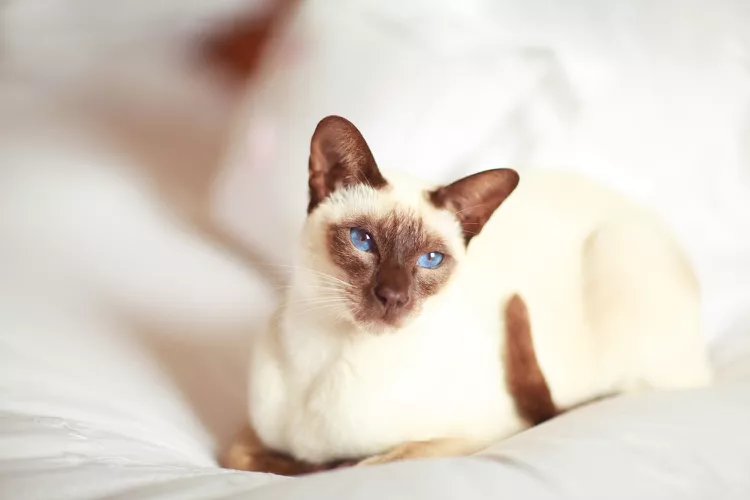- 01 of 10
Abyssinian
The Abyssinian’s ears outstretch to each side as though they're always listening to something. This is one of the oldest cat breeds, though its origin is unclear. Its ancestors likely lived along the Indian Ocean, as well as in Southeast Asia. Modern-day Abyssinian cats are intelligent, playful, and highly active. And they love to be the center of attention.
Breed Overview
Height: 8 to 10 inches
Weight: 8 to 12 pounds
Physical Characteristics: Tall, pointy ears; wedge-shaped head; slender, muscular body
- 02 of 10
Balinese
The Balinese, which sports large triangular ears, likely originated from a genetic mutation that created a longhaired version of the Siamese cat breed. Lithe and muscular, the breed's silky coat lies close to the body and resists matting. These cats are typically affectionate, playful, and chatty. They love hanging out with their families, and they often get along with children and other pets.
Breed Overview
Height: 6 to 7 inches
Weight: 8 to 12 pounds
Physical Characteristics: Wedge-shaped head; slender body; blue eyes
- 03 of 10
Chausie
The Chausie’s tall, wide ears are set at a slight outward angle. This hybrid cat breed was developed in the 1990s from crosses between Abyssinians and jungle cats. Although today’s Chausie is more “wild at heart” than wild, the breed is far from a lap cat. Most prefer lots of attention and interactive play to lounging around the house.
Breed Overview
Height: 14 to 18 inches
Weight: 15 to 30 pounds
Physical Characteristics: Long, tall body; elongated snout; large, sometimes tufted ears
- 04 of 10
Cornish Rex
With its distinctive wavy coat and large, slender, bat-like ears, the Cornish Rex is a delight to behold. The breed gets its name from its place of origin—Cornwall, England—where a kitten with a genetic mutation for a wavy coat was born. Today, these cats are generally intelligent, active, and outgoing. They prefer lots of social interaction but usually aren't gentle lap cats.
Breed Overview
Height: 12 to 14 inches
Weight: 6 to 10 pounds
Physical Characteristics: Curved body; high cheekbones; large ears
Continue to 5 of 10 below - 05 of 10
Devon Rex
The Devon Rex’s enormous ears lend to its “elfin” look and impish expression. This breed is highly social and fun-loving, and some people even describe it as dog-like. With its small build and spunky personality, this cat tends to look and act like a kitten throughout most of its life. The Devon Rex’s coat is soft and wavy, appearing to ripple when you pet it.
Breed Overview
Height: 10 to 12 inches
Weight: 8 to 10 pounds
Physical Characteristics: Large ears; slender neck; prominent eyes
- 06 of 10
Egyptian Mau
The Egyptian Mau has broad ears that curve slightly forward, giving the cat an alert expression. This breed’s ancestors likely came from ancient Egyptian wild cats, and it's the only domesticated cat breed with a natural spotted coat pattern. These athletic cats are notoriously good sprinters and love to climb. Interactive play is important to keep their minds and bodies busy.
Breed Overview
Height: 8 to 10 inches
Weight: 7 to 9 pounds
Physical Characteristics: Long, muscular body; green eyes; large ears
- 07 of 10
Oriental
The Oriental was created from the Siamese, so it’s no surprise this breed has the same prominent, triangle-shaped ears as its cousin. It looks much like the Siamese but comes in even more coat varieties. This fun-loving breed is naturally athletic and playful, and it tends to bond very strongly to its favorite humans.
Breed Overview
Height: 8 to 10 inches
Weight: 6 to 12 pounds
Physical Characteristics: Sleek body; angular head; large ears; almond-shaped eyes
- 08 of 10
Savannah
The Savannah cat is a cross between domestic cats and wild African servals. And the Savannah’s big, tall ears are very much a part of the breed’s overall wild look. These cats are also somewhat wild in demeanor. While they typically love their families and often demand attention, they're also highly intelligent and energetic. It takes a lot to keep them physically and mentally exercised.
Breed Overview
Height: 12 to 14 inches
Weight: 20 to 30 pounds
Physical Characteristics: Tall, lean body; erect ears; golden coat with dark spots and bars
Continue to 9 of 10 below - 09 of 10
Siamese
The Siamese is a sleek cat with prominent ears typically in a darker color than the majority of its coat. Sweet and spirited, this breed has been popular with cat lovers since the late 1800s. These cats are known for their vocalizations and will "chat" with their humans day and night, especially when they have an opinion to express. They like to be the center of attention and prefer company throughout the day.
Breed Overview
Height: 8 to 10 inches
Weight: 8 to 10 pounds
Physical Characteristics: Sleek body; almond-shaped eyes; wedge-shaped head
- 10 of 10
Sphynx
With their wrinkled skin and prominent features, Sphynx cats make a statement. Many of these hairless cats actually have a downy fuzz covering some or all of their bodies. But it's their huge ears and eyes compared to the rest of their head that really draws attention. They're generally friendly and cuddly cats (especially for warmth), and they're known to entertain their humans with clownish antics.
Breed Overview
Height: 8 to 10 inches
Weight: 10 to 12 pounds
Physical Characteristics: Hairless; wrinkled head; lean build




















